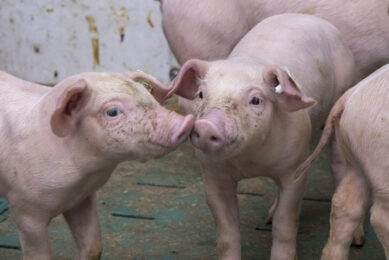Japan’s market for imported pork is large

Japan has long been known as the number one pork importing country in the world. Although it recently lost this position to China, the country’s dependency on pork imports is likely to stay. What does that mean for years to come?
Japan is in the top-10 pork producing countries in the world, and produces around 1.3 million metric tonnes of pork per year. However, 2016 total pork consumption in Japan is about 2.6 million tonnes. In 2015, Japan accounted for almost 20% of the global trade in pigmeat and until this year Japan led the world in the league table for imported pork and pigmeat. It lost that top spot to China in 2016 and may never get it back, but Japanese consumers and the demand for imported pork by Japan will be an important part of the global trade in pigmeat for a long time to come.
Indeed, a shrinking domestic industry, a strong yen, and the prospect of trade liberalisation suggests that the Japanese market for imported pork could be ready for another upward ‘reset’ similar to that which occurred in the early 70s. Pork is the most popular meat in Japan (nearly as much pork is consumed as chicken and beef combined) and tonkatsu (a breaded and deep fried pork loin or cutlet) is a signature dish for the Japanese pig industry. That said, the shrinking and ageing population in Japan presents some challenges to importers wishing to grow the overall market – or even to just grow their market share.
Continuing to consolidate
A recent report by the United States Department of Agriculture (USDA) summarises the state of the domestic pig industry in Japan as continuing to consolidate: swine numbers and pork production are on a downward trend. Between 2014 and 2016 the total number of pig farmers dropped by 8% (now 4,830 farms but there were over 7,000 farmers in 2007) and it is the small- and medium-scale operators who are leaving the industry. Over the same period, total pig numbers fell by 2% to 9.313 million head and the average size of a pig farm grew by 7%, rising to almost 2,000 head per farm.
The spread of Porcine Epidemic Diarrhoea virus (PEDv) has been a feature of Japanese pig production in recent years and its incidence peaked in late 2014. At the beginning of 2016 the breeding herd had declined by 5% to 844,700 head. Feeder piglet numbers were up 17% from 2014 to 692,500 head. USDA reports that ‘these numbers suggest that the worst effects of PEDv in Japan are over’. Japan’s hog slaughter and meat production increased by 3% (8.142 million head, total production of circa 638,678 million tonnes) in the first 6 months of 2016. This is in line with a recovery from PEDv which began in the fourth quarter of 2015. The USDA expects that there will be a slight increase in hog slaughter in the second half of 2016 – implying that the total for 2016 total pig numbers and slaughter will grow by 2% to 16.4 million head (equivalent to 1.28 million tonnes of total production).
Finally, it’s worth noting that Japan’s hog slaughter usually peaks in the autumn and winter months after hot weather and lower meat production in the summer.
Figure 1 – Trend in total pork imports into Japan, 2001 – July 2016.

Japan 50% self-sufficient in pork
The data above immediately define the Japanese economy as being only 50% self-sufficient in pork and being a key part of the global trade in pigmeat with its domestic industry in a process of restructuring. What do the trends for this imported trade look like? Figures 1 and 2 help answer this question and it’s apparent from these that the growth in the total volume of imports is relatively small over a long period. The slight upward trend in total imports occurs mostly since 2010 – and has been influenced by exchange rate changes as the yen’s value against the US dollar and the euro has varied greatly over time. PEDv will also have played a big part in driving pork import demand since 2014 as domestic production and stocks have declined.
Figure 2 – Chilled and frozen pork imports into Japan, Jan 2006 – July 2016.

Figure 2 provides a breakdown of imported pork demand into frozen, and fresh/chilled products. It’s clear from this latter chart that the demand for frozen pork has flat-lined over a long period – albeit having a highly volatile appearance from month to month. Chilled pork products have, however, shown real growth. These different categories of pigmeat are more or less important to different supplying countries. The USA and Canada dominate the fresh/chilled imported pork market and suppliers from the EU dominate the frozen pork market. What, if anything, could change this situation?
Tariff rules
The tariff rules that describe the Japanese import regime for pigmeat are complex and have a long history – but they strictly define the opportunities for current and new import suppliers. These tariff rules are termed the Japanese ‘gate price system’ which allow (or prevent) access to the Japanese market for pork. These restrictions have been in place for many years and are generally agreed to have caused great volatility in the monthly import levels of pork. The system operated, essentially, as a variable levy on foreign supplies of pork and was very efficient in raising import prices and protecting Japanese pig farmers. In 2000, the system was amended and a fixed tariff was introduced (with ad valorem ‘tweaks’ on import prices depending on particular products and whether price levels were above or below predetermined targets). Although still complex, the post-2000 amended system facilitated imports and has helped grow the market.
Fast forward to 2016 and another trade liberalisation measure is promised – TPP. The Trans Pacific Partnership covers the USA and 11 other Pacific-facing nations: Australia, Brunei, Canada, Chile, Japan, Malaysia, Mexico, New Zealand, Peru, Singapore, and Vietnam. Under the TPP agreement, Japan will eliminate tariffs on more than 65% of its pork and pork product tariff lines within 11 years and on nearly 80% of tariff lines within 16 years. Japan’s 20% tariff on ground seasoned pork and 10% tariff on sausages will be eliminated in 6 years. Japan’s current 4.3% tariff on fresh, chilled, and frozen pork cuts will immediately be reduced by 50%, with the residual duty eliminated in ten years. The ‘gate price system’ will remain, but Japan will immediately reduce the specific duty on pork cuts from its previous maximum charge of 482 yen/kg to 125 yen/kg, with a further reduction to 50 yen/kg by year 10.
Clearly, if the TPP is ratified and comes into force the Japanese market for imported pigmeat will grow. Could anything cloud this sunny outlook?
Inability to ratify the TPP
The number 1 doubt about the TPP and its potential gains for US and Canadian pork exporters to Japan is the inability of the US Congress and Senate to ratify this deal. It is unclear if this will happen until after the result of the US presidential election. And even if the US lawmakers support the agreement it may not be ratified by one or more of the other TPP countries.
The number 2 doubt about the Japanese market for imported pork is the relationship between the yen and foreign currencies. It is a price sensitive market and if macroeconomic conditions determine that the yen’s value falls against other currencies then so will the demand for imported products – including pork.
Finally, 3 is doubt number three – the demographics of the Japanese nation. It is one of the few developed countries where the population is in decline – shrinking by 0.19% each year. And nearly 30% of the population is over 65. An older and shrinking population does not spell increased demand for anything much – except health and care services. These last 3 points are all outside the control of pork exporters but need to be watched if the potential of the Japanese market is to be properly understood and acted upon.

Japan at a glance
With a total area of 364,485 km2, Japan is slightly larger than Germany. The climate varies from tropical in the south to cool temperate in north. Japan’s topography is mostly rugged and mountainous – the mean elevation is 438 m and highest point is Mount Fuji at 3,776 m. As a result, the use for agriculture is relatively limited. In total, 12.5% of the land use is agricultural land; arable land 11.7%; permanent crops 0.8%; permanent pasture 0%, forest: 68.5%, other: 19%. In total, Japan’s population amounts to 127 million, with Shintoism and Buddhism 66.8 being the most influential religions. Gross Domestic Product (GDP) per capita is approximately US$38,100 per year.











